“Shoot the women first!”, a German official is reported to have advised in the 1980s when members of GSG-9, the country’s elite anti-terror squad found themselves in front of a large group of people suspected of being terrorists. Eileen MacDonald used the order as the title of the study of female terrorists she wrote in 1991. Navine G. Khan-Dossos, in turn, borrows it for an exhibition that looks at the theme of female targets.
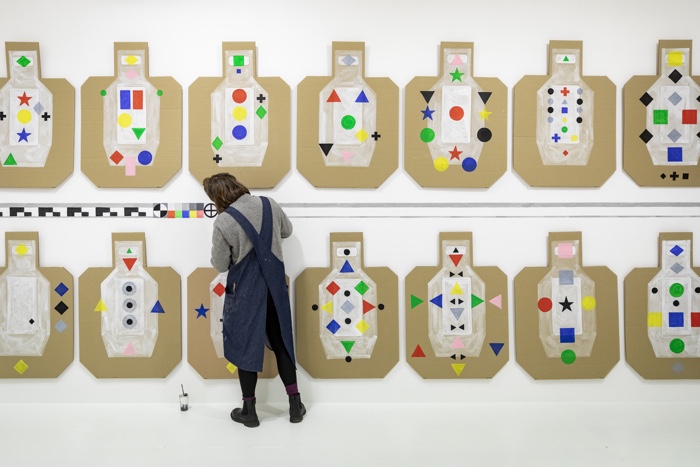
Navine G. Khan-Dossos at Z33 House for Contemporary Art. Photo: Kristof Vrancken Photography and Research
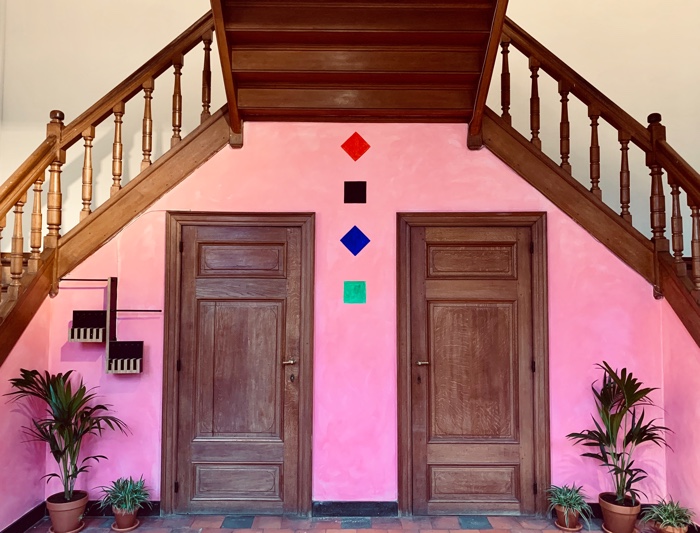
Navine G. Khan-Dossos painted in pink one of the walls at the entrance of Z33 House for Contemporary Art. Photo:
For Shoot the Women First, her solo exhibition at Z33 in Hasselt, the artist recreated a shooting range. Paintings in soft colours are hanging on the wall and from the ceiling. The first ones you encounter carry symbols similar to the type of targets used in Discretionary Command training. During those police and military trainings, shooters receive a chain of commands which require them to shoot at triangles, circles and squares of various colours in a certain order.
As you walk through the exhibition space, the reference to a body become less abstract and you soon recognize human shapes on the paintings. The exhibition is choreographed so that your body comes in close proximity of the targets, making the experience feel somewhat ominous and almost visceral.
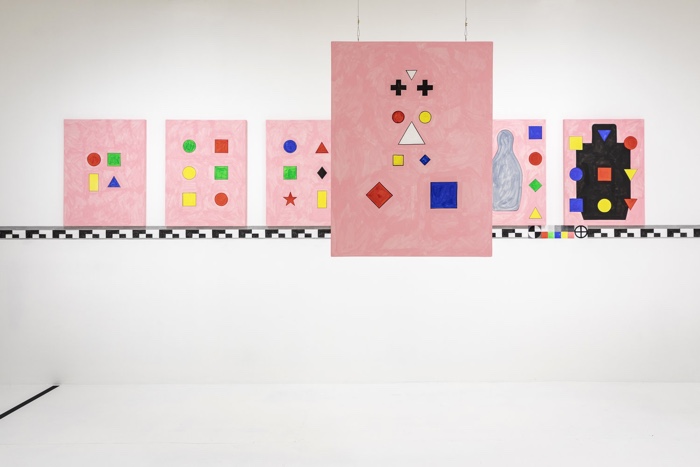
Navine G. Khan-Dossos, Pink Discretionary Command, 2018 at Z33 House for Contemporary Art. Photo: Kristof Vrancken Photography and Research
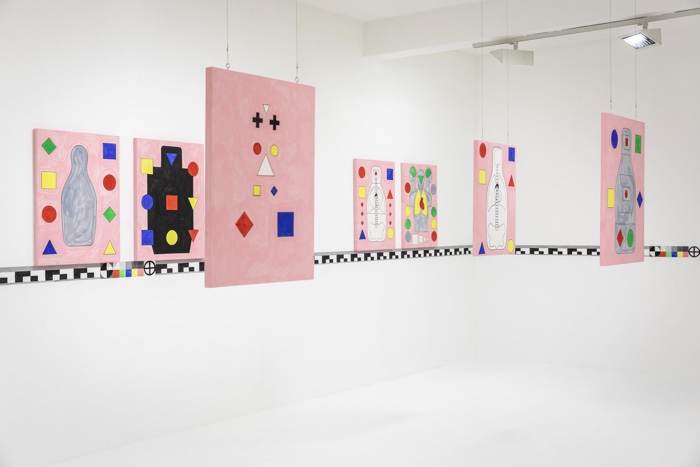
Navine G. Khan-Dossos, Pink Discretionary Command, 2018 at Z33 House for Contemporary Art. Photo: Kristof Vrancken Photography and Research
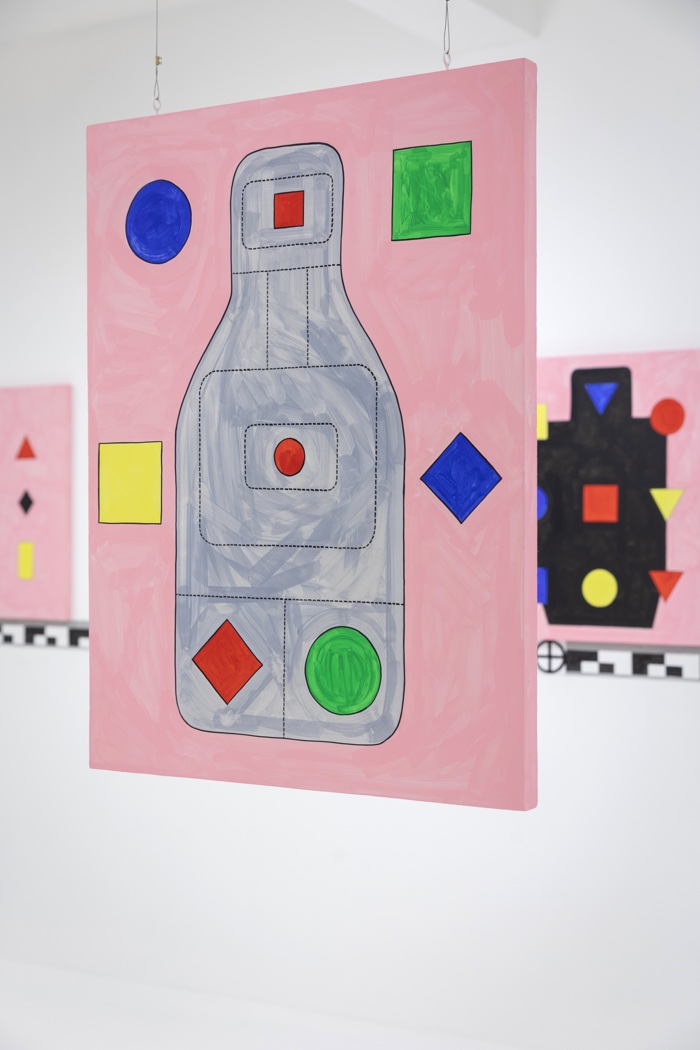
Navine G. Khan-Dossos, Pink Discretionary Command, 2018 at Z33 House for Contemporary Art. Photo: Kristof Vrancken Photography and Research
All the works in the series feature the colour pink. Not any type of pink but the particular shade of pink used to paint the doorways of brothels in the Metaxourgeio neighbourhood of Athens.
The area was the theater of police brutality against women in 2012 when a group of drug-users were arrested and forced to undergo HIV tests. It was assumed that the women were prostitutes. They were imprisoned on charges of grievous bodily harm for transmitting the virus through sex work. Most of these women had never worked as prostitutes and were not even aware they were HIV-positive. The violence towards them didn’t end there. The police published their mug-shots and personal data on their website and the images spread from there to major TV channels and other media. Eventually the charges were dropped, but some of these women struggled to recover from this experience of incarceration and public shaming.
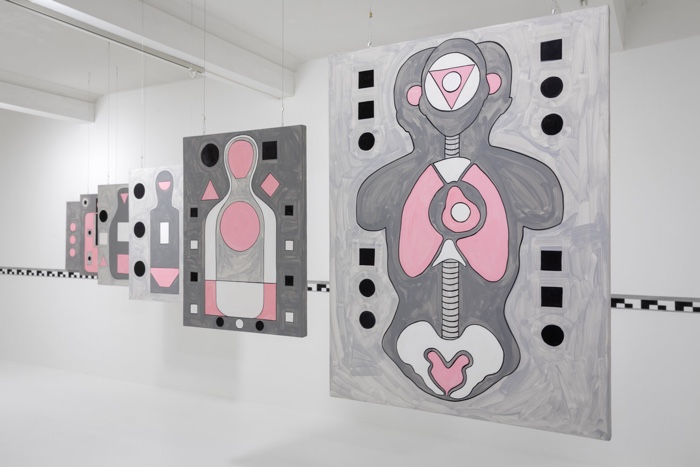
Navine G. Khan-Dossos, Grey Discretionary Command, 2018 at Z33 House for Contemporary Art. Photo: Kristof Vrancken Photography and Research
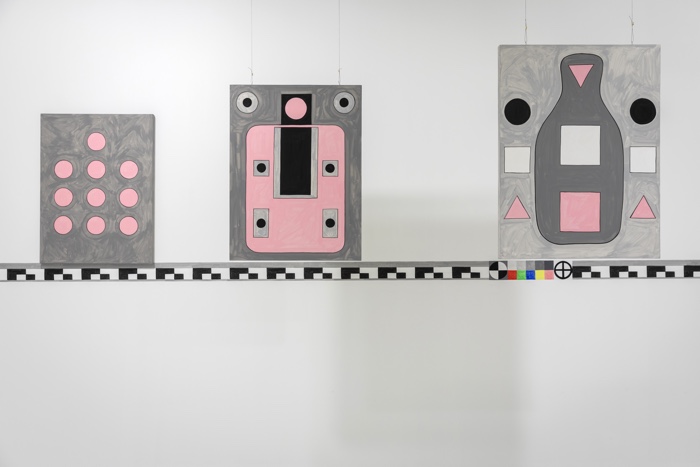
Navine G. Khan-Dossos, Grey Discretionary Command, 2018 at Z33 House for Contemporary Art. Photo: Kristof Vrancken Photography and Research
Being diagnosed with HIV meant that, for the authorities, the body of these women epitomized deviance and bio-terrorism. They were both a danger and a target, both victims of society and perpetrators of sexual disorder. The colour pink in the paintings is thus not one that evokes innocence and romanticism but violence, violation of privacy and HIV criminalization.
Khan-Dossos managed to give a presence to these women without ever using the humiliating mugshots that had been shared online and in the Greek mainstream media.
Shoot the Women First demonstrates that it is possible to use abstract forms to convey a poignant narrative, to talk about violence without using explicit images. Perhaps, that’s the smartest way to do it now that images of violence are so commonplace online that we barely register them.
The work doesn’t address only the fate of these women but also the one of other marginalized bodies. The pink triangles in some paintings allude to the rise of AIDS activism, and in particular ACT UP’s SILENCE = DEATH posters. The work also refers to the militarization of the US police and their use of lethal weapons against civilians. And in general, the harassment of women worldwide which, as recent stories like the Ligue du LOL in France and the Spanish far-right parties pushing back against gender equality indicate, shows no sign of abating. Not even in 21st Century EU.
While writing this review, i also couldn’t stop thinking about 19 year old Shamima Begum. In 2015, she was an English schoolgirl who left her family to join the so-called Islamic State. We don’t know whether she committed crimes while in Syria. The United Kingdom has nevertheless decided to revoke her citizenship and the young woman now sits in a Syrian refugee camp with her newborn son. A few days ago, a shooting range in north-west England has made headlines for using a photo of her face as a target, following “a large number of requests from customers.”
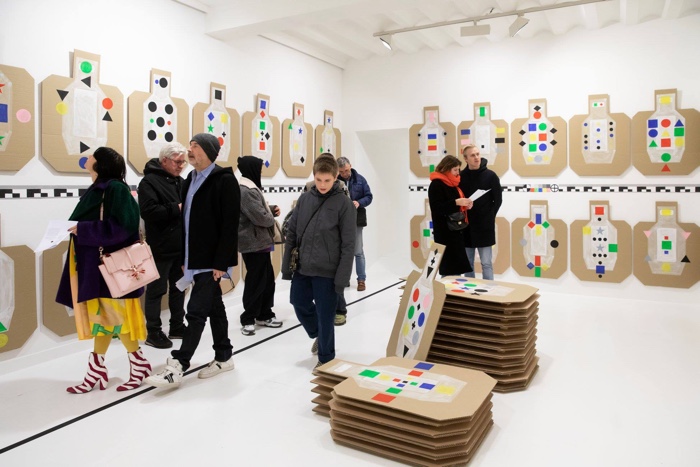
Navine G. Khan-Dossos, Bulk Targets 1-100, 2018. Opening at Z33 House for Contemporary Art. Photo: Kristof Vrancken Photography and Research
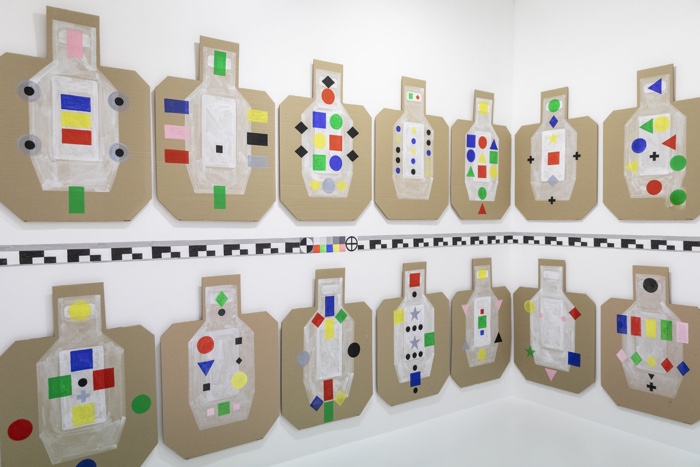
Navine G. Khan-Dossos, Bulk Targets 1-100, 2018. At Z33 House for Contemporary Art. Photo: Kristof Vrancken Photography and Research
One room is filled with heaps of gouaches on cardboard. The shape and number of ‘Bulk Targets 1-100’ refer to the target models for training. The vast number of these works on a humble material suggests their throw-away use, the sheer banality of violence. On the other hand, they also hint at the possibility that we can make them ours and train as an army that would fight against the demonization of vulnerable people.
The exhibition also features one of Khan-Dossos’ motifs: a standard forensic ruler that runs the walls of the exhibition rooms and transforms the gallery into a crime scene. Crime investigators use forensic rulers to facilitate photographic documentation of evidence at crime scenes. Its title, Below the Belt, evokes not only the unfair and slightly cowardly practices that often accompanies gender politics but also the physical and metaphorical site of domestic violence and control.
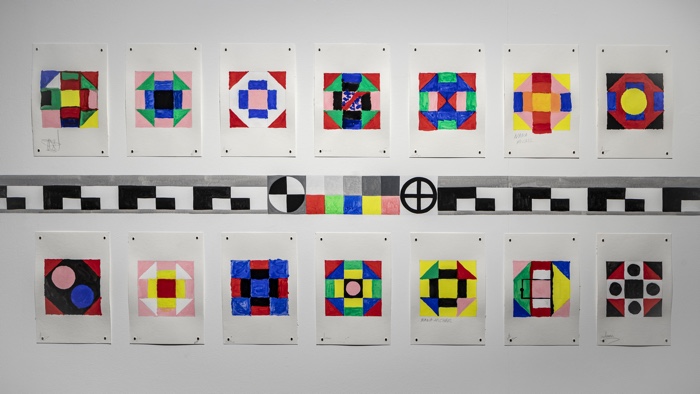
Navine G. Khan-Dossos, Silent Latitude (detail) and Below the Belt (detail), 2018 at Z33 House for Contemporary Art. Photo: Kristof Vrancken Photography and Research
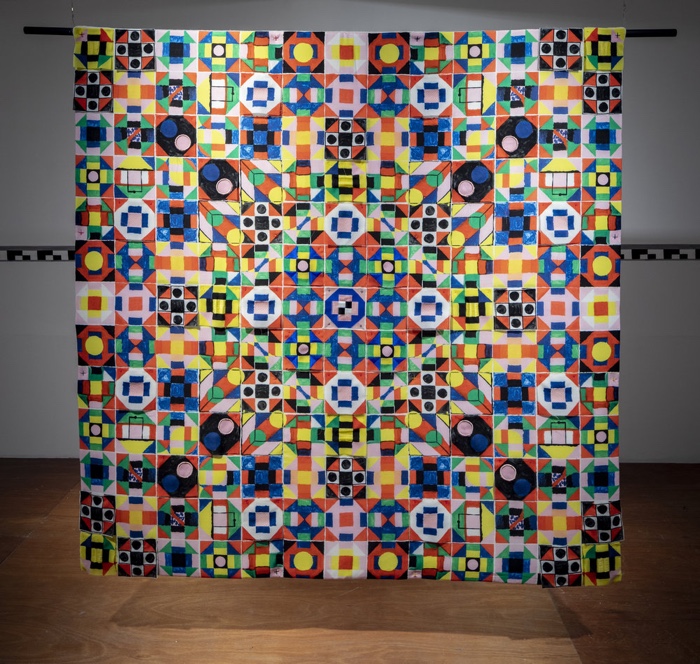
Navine G. Khan-Dossos, Silent Latitude, 2018 at Z33 House for Contemporary Art. Photo: Kristof Vrancken Photography and Research
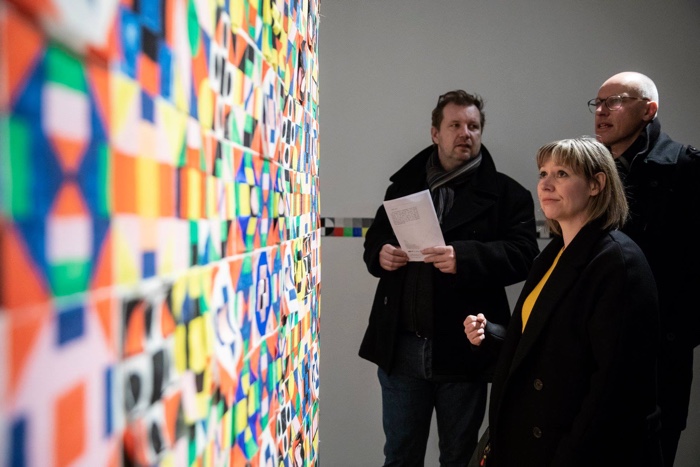
Navine G. Khan-Dossos, Silent Latitude, 2018. Opening at Z33 House for Contemporary Art. Photo: Kristof Vrancken Photography and Research
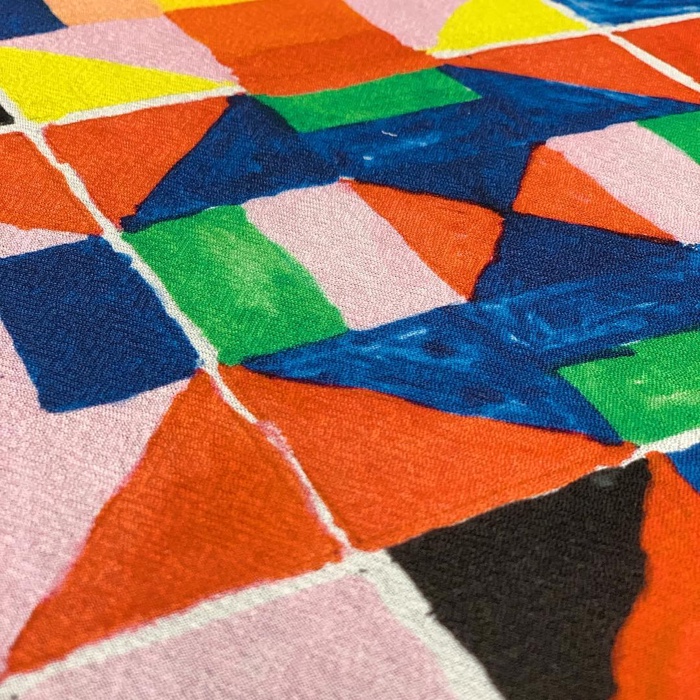
Navine G. Khan-Dossos, Silent Latitude (detail), 2018 at Z33 House for Contemporary Art. Photo: Kristof Vrancken Photography and Research
The last work Khan-Dossos is showing in Hasselt is Silent Latitude. This new commission is part of the other exhibition you can visit now at Z33: Dissidence – Quilting Against. Silent Latitude is a quilt designed together with the members of the Greek Trans Support Association in Athens and embroidered with the help of MIA-H Fashion Incubator for Accessories in Hasselt. This “community-made textile” evokes the value of collective labour as a healing and bonding activity, referring to the Beguines, laywomen from the urban middle class who lived together in domestic spaces (such as the ones that house Z33 exhibition spaces), supporting themselves with their labor, outside of male control and without submitting to monastic rule.
Ending the show with the quilt lifts up the spirits. The work points to a more hopeful humanity, one that relies on solidarity to create, defy and resist.
Navine G. Khan-Dossos – Shoot the Women First was curated by Silvia Franceschini. Dissidence – Quilting Against was curated by Ronald Clays. Both exhibitions remain open until 26 May at Z33 – House for contemporary art in Hasselt, Belgium.
Photos of the opening ‘Shoot the Women First’ & ‘Dissidence’.
India Doyle did a fascinating interview with Navine G. Khan-Dossos for Twin back when the artist was showing the first iteration of Shoot the Women first at The Breeder gallery in Athens. Also worth your time: Ruins – Chronicle of an HIV witch-hunt, a documentary directed by Zoe Mavroudi about the women victims of HIV criminalization in Athens.
Previously: Painting on and painting off ISIS propaganda.
